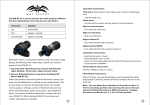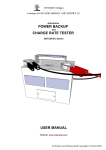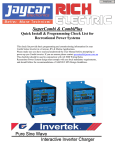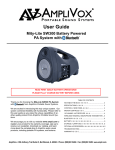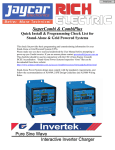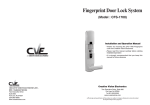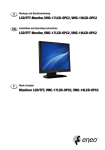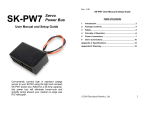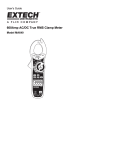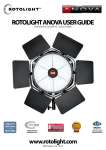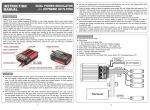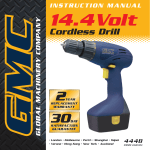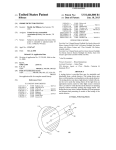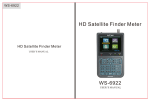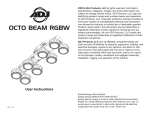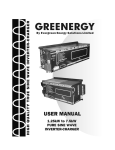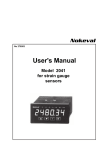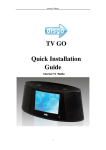Download LOAD-TESTER USER MANUAL
Transcript
ONTARIO Designs ---------------A division of ONTARIO IMPORT AND EXPORT CC LEAD-ACID BATTERY LOAD-TESTER ONTLT6000 Series USER MANUAL Website: www.ontarioza.com All Product and Printing detail Copyright© Protected 2012 Content: Introduction .................................................1 Features ......................................................1 Accessories .................................................3 Testing Procedures .....................................4 Trouble Shooting .........................................5 Maintenance ................................................6 Safety Instructions .......................................6 Technical Specifications ..............................6 Limited Warranty .........................................7 Ordering ......................................................7 Manufacturer Declaration ............................8 Support and Contact Information .................8 All Product and Printing detail Copyright© Protected 2012 Introduction: The ONTLT6000 series LOAD-TESTER is used for testing 12Volt lead-acid batteries. It uses carbongraphite technology to test battery crank and amp-hour capabilities. The tester is specifically designed for high volume battery sales industries that need true and accurate test results. The primary function of lead acid batteries is for starting automotive vehicles. For this batteries need “cold-cranking” and “amp-hour” capabilities that can only be tested by cranking the batteries to the required specification. This testing procedure still remains the most accurate way to test lead-acid batteries today. As lead-acid batteries get older they lose amp-hour due to sulfation. Some testers on the market can not identify this sulfation problem because large amount of energy must be drawn from the sulfated battery. Test equipment needs to dissipating this energy which small digital testers simply can not do. Faulty batteries also display a characteristic referred to as “a dead cell”. The carbon-graphite loadtester can detect this immediately. Features: 1. 6000Watt Rated Dissipating Load Capabilities The dissipation material has been designed with 3mm thick copper bars and a 612cm² carbongraphite block. None of the internal components are glued to perform high temperatures energy dissipation. This enables the load-tester to perform continuous crank tests at 600Amp for up to 30seconds to help identify those difficult to spot sulfated batteries. 2. Handcrafted Industrial Clamps To perform 600Amp crank tests no short cuts are taken on the clamp design. 3mm thick handcrafted copperheads conduct electricity effectively from terminal to clamp. The large copper volume protects the battery poles from over heating. The copperheads are bridged so that both will conduct equal current, eliminating failures on the clamp spring. Page 1 All Product and Printing detail Copyright© Protected 2012 3. Flush Panel Meters The panel meters fit flush into the load-tester. This minimizes damage to the meters. 4. True Non-Linear “Crank & Amp-hour” Graph A Copyright© protected “crank & amp-hour” display with non-linear graph characteristics ensures accurate tests on all lead-acid battery capacities up to 180 amp-hour. As a result of the non-linear characteristics even small battery sizes are tested accurate. 5. Non-Abrasive Insulation Material Application specific non-abrasive insulation material has been chemically engineered which enables the load-tester to perform high volume battery tests. Page 2 All Product and Printing detail Copyright© Protected 2012 Accessories: ONTTR001 Trolley (Used with ONTLT6000 Carbon Load-Tester) A handy trolley (refer to ordering page 7) can be used for conducting tests next to the vehicles without removing the battery. The operator does not have to carry the load-tester by hand. A counterweight, (not included) such as a 619 lead-acid battery or a 12v26 sealed lead-acid battery, can be used to stabilize the trolley. ONTCEPS12 Backup A small handy tool (refer to ordering page 7) for providing vehicle power backups while performing automotive battery tests. This product also performs a complete alternator charge rate test. Page 3 All Product and Printing detail Copyright© Protected 2012 Testing Procedures: 1. Clamp Connections: Clamp Connections on Free Standing Batteries Turn the load-tester valve anticlockwise to the full “OPEN” position before connecting. Failure to perform this procedure may cause an electric spark. Clean the battery lead-terminals. Place the (red) clamp jaw around positive (+) lead-terminal. Place the negative (black) clamp jaw around the negative (-) lead-terminal. Different clamp angles may be used. Small battery terminals including motorcycle terminals can also be clamped. Clamp Connections on Installed Automotive Batteries Turn the load-tester valve anticlockwise to the full “OPEN” position before connecting. Failure to perform this procedure may cause an electric spark. Clean the car-terminals. Place the positive (red) clamp around positive (+) car-terminal. Place the negative (black) clamp jaw around the negative (-) car-terminal. Different clamp angles may be used. When performing a crank test (refer “Crank Tests”), take care not to let the system voltage drop below 8 Volt. Below this the vehicle may have electronic memory loss including radio setup, window position calibration and alarm program. As a precautionary measure the vehicle power can be backed up with an alternative battery power source and the carterminals disconnected. The standard test procedure for free standing batteries may now be performed. Refer to page 3 for the handy “ONTCEPS12 Backup” accessory. Page 4 All Product and Printing detail Copyright© Protected 2012 2. Crank Tests: Charged lead-acid battery test procedure: Conduct a hydrometer test on a lead-acid battery with caps. Most batteries are charged at 1.260 specific gravity on sulfuric-acid. With sealed lead-acid batteries the charge state can be checked with a Voltmeter. The charge state is usually above 12.4 Volt (allow chemical state to stabilize). With the clamps connected (refer “Clamp Connections”) turn the load-tester valve clockwise. The needle on die Amp-Panel-Meter will shift to the right of the graph. Turn the valve till the needle reaches the amp-hour battery specification and hold for 10 seconds. The needle on the Volt-PanelMeter should not drop below the 10V highlighted mark. Open the valve anticlockwise again. Note: A buffer on the amp graph has been added for “low quality batteries” with inferior performance. Use own discretion. Discharged lead-acid batter test procedure: Conduct a hydrometer test on a lead-acid battery with caps. Most batteries are discharged at 1.100 specific gravity on sulfuric-acid. On sealed lead-acid batteries the charge state can be checked with a Voltmeter. The discharge state is usually below 12.4Volt (allow chemical state to stabilize). With a capped discharge battery a “dead cell” can be spotted easily by following the following procedure: Open all 6 battery caps. With the clamps connected (refer “Clamp Connections”) turn the load-tester valve clockwise as far as possible. The needle on die Amp-Panel-Meter will shift to the right but not far enough because of the discharged battery state. If you can spot only 1 cell with a lot of catalytic activity (boiling cell) this would be a problematic cell and the battery would have to be replaced. With a sealed discharge battery the battery must first be charged before performing the “charged lead-acid battery test procedure”. Sulfated lead-acid battery test procedure: Vehicle owners sometimes experience the case where batteries don't start the engine after not driving the vehicle for a day or more. These batteries are usually sulfated batteries. Most test equipment can not identify the sulfated batteries because after driving for a while the batteries will perform correct. The sulfated batteries can be identified by the following test procedure. Disconnect the battery from the vehicle. As a precautionary measure the vehicle power can be backed up with an alternative battery power source. Refer to page 3 for the handy “ONTCEPS12 Backup” accessory. Perform the standard “charged lead-acid battery test procedure”. Let the equipment cool down (± 1 minute) and repeat the procedure 4 times. A sulfated battery will not pass the test as the volt needle will start to drop slowly. Trouble shooting: Panel meters do not detect any voltage Clean battery poles and load-tester clamps. If problem persists, send product to nearest sales representative for repairs. • Panel meter needle shifts to the incorrect (left) side. Reverse polarity. • Panel meter needle not on zero point Send product to nearest sales representative. • Load tester makes internal spark noises when performing tests Send product to nearest sales representative for repairs. • Page 5 All Product and Printing detail Copyright© Protected 2012 Maintenance: • • • • The copperheads on the clamps should be kept clean with a solution of hot water and bicarbonate of soda. Do not let the inner components come into contact with water. The casing, panel meters and clamp-cables may be cleaned with a soft damp cloth. Do not drop the load tester onto hard services or let it fall. This may cause damage and void the warranty. Safety Instructions: • • • • • • • • • The ONTLT6000 load-tester is designed for testing 12Volt lead-acid based batteries. Do dot use the load-tester for any other purpose. Always make sure the load-tester valve is in the full open position before connecting the clamps. Do not perform a test on a hot battery with a hissing sound from excessive gassing. A load-tester with damaged cables should not be used. Repairs should be performed by a ONTARIO IMPORT AND EXPORT CC representative. Always use protective gear including safety glasses when working with lead-acid batteries. Batteries emit explosive gas. It is recommended to open battery caps if possible before performing any tests. Never smoke or allow open sparks near the vicinity of the battery. Lead-acid battery acid is corrosive. If acid come into contact with eyes, rinse with fresh water and seek immediate medical advice. Allow sufficient ventilation when using the load-tester. This product should not be used by children. Technical Specifications: Load Tester Model ONTLT6000 Rated crank amps 600 Amp for 30seconds Rated Input Voltage 0-15Vdc, 20Vdc max for 20 seconds Rated Reverse Voltage (Do not operate -15Vdc for 5 seconds in this mode) Battery Types 12V Lead-Acid based (Wet, Flooded, MF, CaCa, Gel, AGM, PbCrystal, Planté, Tubelar, DeepCycle) Battery Capacity 5 Amp-Hour to 180 Amp-Hour Dimensions on casing 215mm x 199mm x 230mm (Length, Width, Height) Indicators (Panel Meters) Analogue, wide view Dimension on Panel Meter View Area 69mm x 34mm (LxH) Clamp Cable length 1.3 Meters Clamp Grasp Displacement 90 mm Probe Measurement Direct on battery poles, zero voltage loss Carbon Amorphous graphite, medium grain, impurities present Weight 8.4Kg Page 6 All Product and Printing detail Copyright© Protected 2012 Limited Warranty: This product carries a 1 year limited warranty to the original purchaser on manufacturing faults. The receipt (proofing date of purchase) and the product must be returned to a ONTARIO IMPORT AND EXPORT CC representative. The warranty is void if load-tester casing has been opened by any one else. The warranty is also void when handled carelessly. ONTARIO IMPORT AND EXPORT CC will not be held responsible for any damages on other products nor personal injury when using our products. Ordering: Product Illustration Carbon-Graphite 6000Watt 12V Lead-Acid Battery LoadTester Ordering Code ONTLT6000 Accessories (Not included with ONTLT6000) Trolley for ONTLT6000 Load-Tester Automotive power backup unit with build in alternator charge rate testing feature ONTTR001 ONTCEPS12 www.ontarioza.com Page 7 All Product and Printing detail Copyright© Protected 2012 Manufacturer Declaration: Designer: ONTARIO Designs a division of ONTARIO IMPORT AND EXPORT CC Manufacturer: ONTARIO IMPORT AND EXPORT CC (South Africa) This product has been designed by a team with years experience in the lead-acid battery retail and wholesale industry including electronic engineering. The product is engineered to be robust and accurate for professional customer service. The manufacturer tests, calibrates and approves all products to high standards. Support and Contact Information: ONTARIO IMPORT AND EXPORT CC offers professional customer support: www.ontarioza.com Director: Petrus Jacobus Nel Electronic Engineer (B.Eng) ONTARIO IMPORT AND EXPORT CC Page 8 All Product and Printing detail Copyright© Protected 2012










